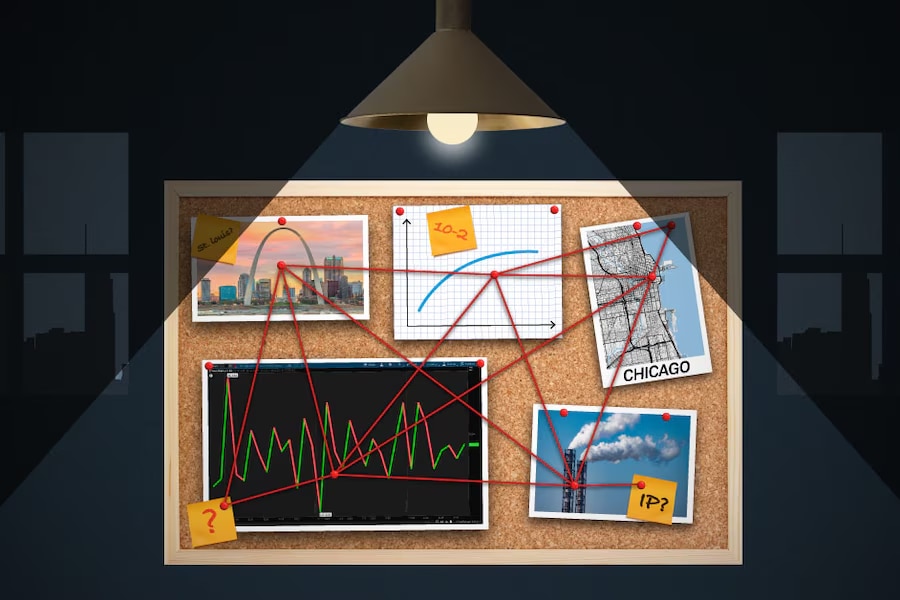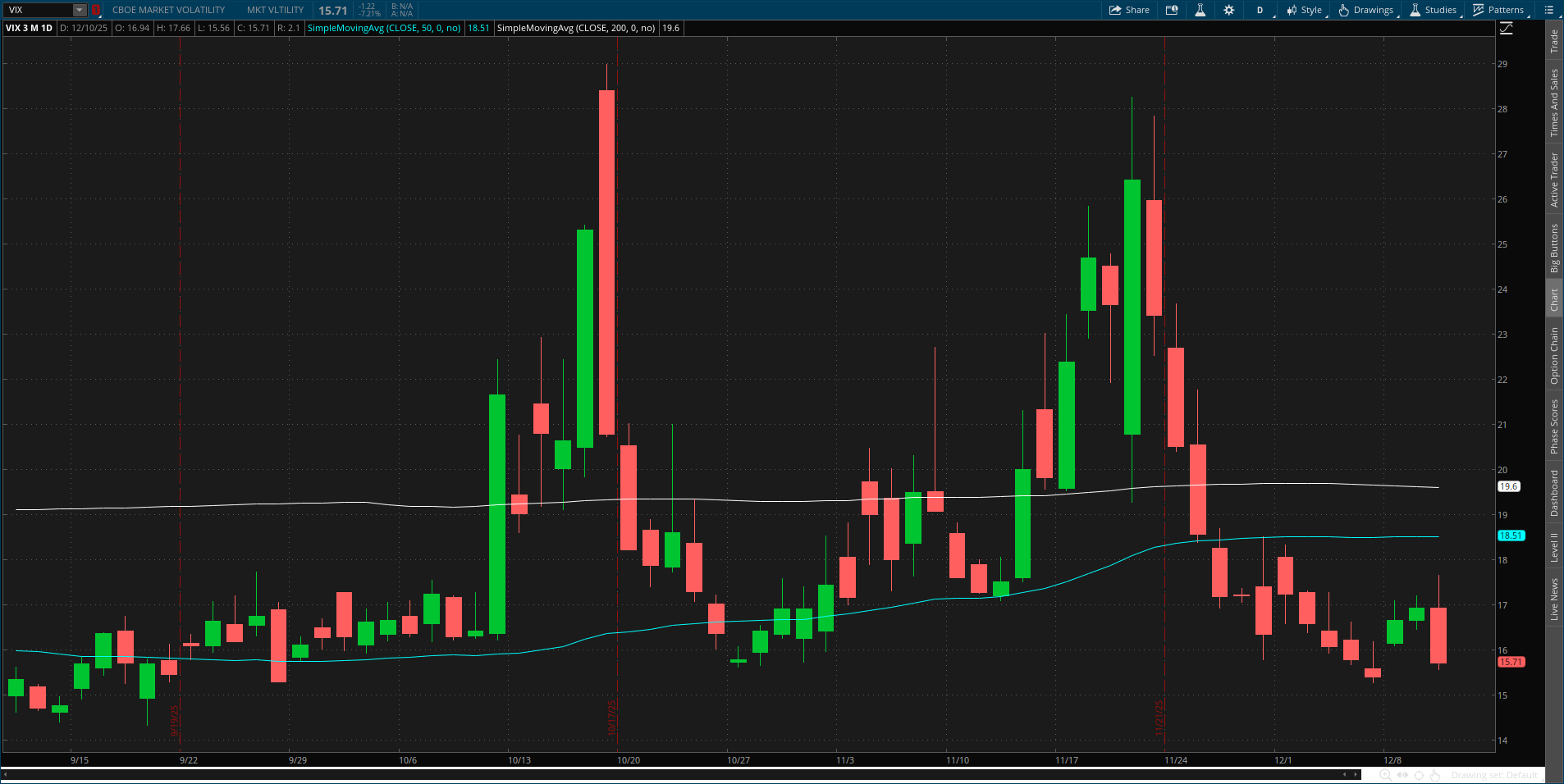Oracle Pops Powell's Balloon, Broadcom Bats Next

Published as of: December 11, 2025, 9:18 a.m. ET
Listen to this article
Listen here or subscribe for free to the Schwab Market Update in your favorite podcast app.
| The markets | Last price | Change | % change |
|---|---|---|---|
| S&P 500® index | 6,886.68 | +46.17 | +0.67% |
| Dow Jones Industrial Average® | 48,057.75 | +497.46 | +1.05% |
| Nasdaq Composite® | 23,654.15 | +77.67 | +0.33% |
| 10-year Treasury yield | 4.12% | -0.04 | -- |
| U.S. Dollar Index | 98.32 |
-0.45 |
-0.47% |
| Cboe Volatility Index® | 15.94 | +0.17 | +1.08% |
| WTI Crude Oil | $57.69 | -0.77 | -1.32% |
| Bitcoin | $90,215 | -$2,570 |
-2.77% |
(Thursday market open) The Federal Reserve's rate cut and upbeat outlook put Wall Street in a good mood that quickly got spoiled by Oracle (ORCL). Shares tumbled more than 13% in pre-market trading after the firm's quarterly revenue disappointed, dragging down other AI-related names including Nvidia (NVDA) on concerns that AI spending isn't being rewarded. Broadcom (AVGO) reports after the close, providing another perspective.
While Fed Chairman Jerome Powell sounded dovish in some respects, he also strongly hinted at a rate pause. He noted that after 75 basis points of cuts since September, the current target range "is in a broad range of estimates of neutral value," and the committee "is well positioned to wait and see how the economy evolves from here." The Fed's "dot plot" of rate projections forecasts just one cut in 2026, in contrast to futures trading that predicts two to three, according to the CME FedWatch Tool. But Fed projections are wide. "The dot plot is starting to look like confetti thrown on a piece of paper," said Kathy Jones, chief fixed income strategist at the Schwab Center for Financial Research.
Major indexes closed near all-time highs Wednesday after the rate move, led mainly by cyclical sectors like industrials and discretionary that drew support from the Fed's bullish quarterly economic projections. The Fed sees stronger gross domestic product (GDP) and slower inflation growth next year. Yesterday's Fed decision—along with the AI earnings this week and next Tuesday's November nonfarm payrolls report—could help shape trading trends into the new year. One trend Powell noted is consumer resilience, and many participants at this week's Goldman Sachs (GS) industry conference also talked up the strength they're seeing this shopping season. This had many retail stocks on the upswing even before the Fed's cheery tidings.
To get the Schwab Market Update in your inbox every morning, subscribe on Schwab.com.
Three things to watch
- Oracle plunges, Broadcom awaits: Oracle missed on revenue, though earnings per share easily topped expectations. Drilling down, investors seemed disappointed in cloud growth and unimpressed by remaining performance obligations that rose 438% year over year during the quarter and 15% sequentially but still missed expectations. Much of this depends on OpenAI, a firm that isn't profitable. In addition, Oracle raised its spending forecast, increasing concerns about the company's borrowing money to build its AI footprint. Several analysts lowered their price targets on Oracle. When Broadcom reports, investors might want color on the company's strategic collaboration with OpenAI. Broadcom shares catapulted along with Alphabet (GOOGL) this quarter as investors cheered Alphabet's new Gemini 3 platform—many of Alphabet's chips are designed by Broadcom. In the massive hunt for cheaper AI, Alphabet and Broadcom appear to be making inroads against market leader Nvidia, Barron's reported, and Broadcom's results could provide clues into the AI market share dynamic.
- Could yields spoil the Christmas party? Late December is traditionally a festive time on Wall Street. This year, the jury is still out, considering the market's lack of traction in testing all-time highs. The S&P 500 index closed Wednesday just below the record of 6,890 after trading above that intraday, which could be a caution sign. Another is the 10-year Treasury note yield, which hit a three-month high above 4.2% early Wednesday before sliding when Powell announced a plan to start buying short-term bonds and expand the Fed's balance sheet. Before the meeting, the 10-year yield had risen 20 points from recent lows, a sign that investors increasingly worry about U.S. debt issuance, inflation, and even Fed independence with Powell's term ending in May. An expected rate hike from the Bank of Japan (BOJ) later this month also could raise yields. If yields spike again, they might hurt rate-sensitive equities. Ironically, small-caps made new all-time highs again Wednesday, which could suggest at least some of the steeper yield curve reflects economic optimism. Also, the 10-year yield remains well below its January peak of 4.8%. The 200-day moving average at just under 4.25% is above and could be worth watching.
- Some Christmas cheer for bitcoin holders: Bitcoin bulls just got a little gift from the Fed. Sure, the rate cut was priced in and rate projections for 2026 remain unchanged. But the restarting of monthly Treasury purchases was good news and should support bitcoin, said Jim Ferraioli, director of digital currencies research and strategy at the Schwab Center for Financial Research (SCFR). Bitcoin has been rangebound in subdued trading as investors looked for a signal following the October-November selloff. Data point to a market lacking conviction: Exchange-traded funds (ETFs) are still seeing outflows, open interest on bitcoin futures at the CME hit the lowest in two years earlier this month, spot volume has been thin, and options data point to defensive positioning, according to data provider Glassnode. And bitcoin futures (/BTC) dropped more than 2.7% early today. While the macro environment just turned more favorable, market sentiment is another matter, and any persistent rally will require a sustained increase in on-chain activity, Ferraioli said.
On the move
Broadcom: Shares fell 1.2% ahead of this afternoon's earnings. Guidance could also be key, providing perspective on AI demand heading into 2026. One worry going in is that even if Broadcom reports solid chip sales, it might reinforce concerns about heavy spending by its peers, Barron's noted.
Adobe (ADBE) shares inched up 0.5% after the software firm's earnings beat expectations late yesterday. Revenue rose 10.5% year over year, led by digital media. The company also provided better-than-expected guidance for the first quarter and fiscal 2026.
Nvidia dropped 1.3% in early trading, hit by AI pessimism stirred by Oracle that sent shares of other chip stocks down as well. Some names in the red before the open include Advanced Micro Devices (AMD), Intel (INTC), Marvell Technology (MRVL), CoreWeave (CRWV), Micron (MU), and Palantir (PLTR). CoreWeave was the hardest hit, down more than 4%.
Semiconductors ended Wednesday at all-time highs after the post-Thanksgiving rally. That's a concern of its own, however, as high valuations could make these shares vulnerable to a pullback on any bad news.
Uber (UBER) continued its slide on Wednesday, falling 5.6%. The rideshare and delivery company is coping with regulatory pressure in Europe and Canada, which were recently spurred on by protests from taxi drivers in Barcelona. Morgan Stanley also slashed its price target for Uber to $110 earlier this week. Shares of Uber competitor Lyft (LYFT) fell 6.7% Wednesday.
Warner Bros Discovery (WBD) stock continued its rise, jumping 4.5% Wednesday amid a bidding war for the company between Paramount Skydance (PSKY) and Netflix (NFLX). Paramount launched a $108 billion hostile takeover bid for Warner Bros this week in an eleventh-hour attempt to prevent Netflix from acquiring the company.
Netflix revived almost 1% this morning but fell for the fourth straight session yesterday as investors focused the on potential acquisition of WBD. Some analysts call the deal expensive and suggest it could be a response by Netflix to combat weak engagement trends, Investor's Business Daily reported. They also cite regulatory risks.
Walt Disney (DIS) climbed 1% after CNBC reported the company is making a $1 billion investment in OpenAI.
Bitcoin (/BTC) tumbled today despite the Fed's Treasury purchase announcement, and crypto-related stocks also slid. This could reflect a risk-off attitude in the market connected partly to rough sledding in AI stocks.
Crude oil futures (/CL) fell more than 1% early today to near the low end of the recent range. This came after OPEC kept its global demand growth forecasts unchanged for this year and next and as focus turned to Ukraine peace talks.
Weekly initial jobless claims jumped to 236,000 last week from 192,000 the week before. Some of these gyrations could reflect the short Thanksgiving holiday week, and may be discounted, and there was a big drop in continuing claims.
More insights from Schwab
Get expert insights on market drivers and their potential impact on your portfolio
Get expert insights on market drivers and their potential impact on your portfolio: Join us for this Schwab Coaching special event: the 2026 Market Outlook at 7:00 p.m. ET tonight. Just tune in to our media affiliate Schwab Network™ to see what our experts think might affect the markets next year.

Almost-famous data: While most investors are familiar with economic indicators like gross domestic product (GDP), unemployment rates, and the consumer price index (CPI), they give investors only a limited view of the economy. Researching lesser-known economic indicators on the thinkorswim® platform can help investors get a broader sense of economic conditions and potentially elevate their game. Learn in this article how to find indicators like the Chicago Fed National Activity Index, the Yield Curve Spread, the St. Louis Fed Financial Stress Index, and other helpful numbers on the platform.
Scrutinizing the Fed's move and outlook: For more insight and observations on the Fed meeting and its possible impact, check out my colleague Kathy Jones' review. "We see the Fed funds target rate at somewhere in the 3% to 3.5% area by the end of 2026, down 25 to 50 basis points from the current level," she writes. "Unless the economy weakens considerably or inflation falls, that's about as low as it makes sense for rates to fall."
The affordability factor: The cost of goods is a hot topic on Main Street and Pennsylvania Avenue, along with another potential government shutdown looming at the end of January, inflation, and jobs numbers. The latest episode of Washington Wise covers these topics and more with guest Kevin Gordon, head of macro research and strategy, SCFR.
Chart of the day

Data source: CBOE. Chart source: thinkorswim® platform.
Past performance is no guarantee of future results.
For illustrative purposes only.
The Cboe Volatility Index (VIX) fell sharply Wednesday in the wake of the Fed's rate cut and Chairman Powell's relatively dovish press conference. After spiking above 28 twice in the past 90 days, the VIX has been relatively subdued in recent weeks despite concerns over elevated tech valuations, stubborn inflation, and a weakening labor market. The index trades well below both its 50-day and 200-day moving average, suggesting some market complacency regarding current risks to equities amid rising investor confidence.
The week ahead
Check out the investors' calendar for a summary of the top economic events and earnings reports on tap this week.
December 12: No major earnings or data expected.
December 15: No major earnings or data expected.
December 16: November nonfarm payrolls, October retail sales, and expected earnings from Lennar (LEN).
December 17: Expected earnings from General Mills (GIS) and Micron (MU).
December 18: November CPI and core CPI, and expected earnings from Accenture (ACN), Cintas (CTAS), Carnival (CCL), Nike (NKE), and FedEx (FDX).